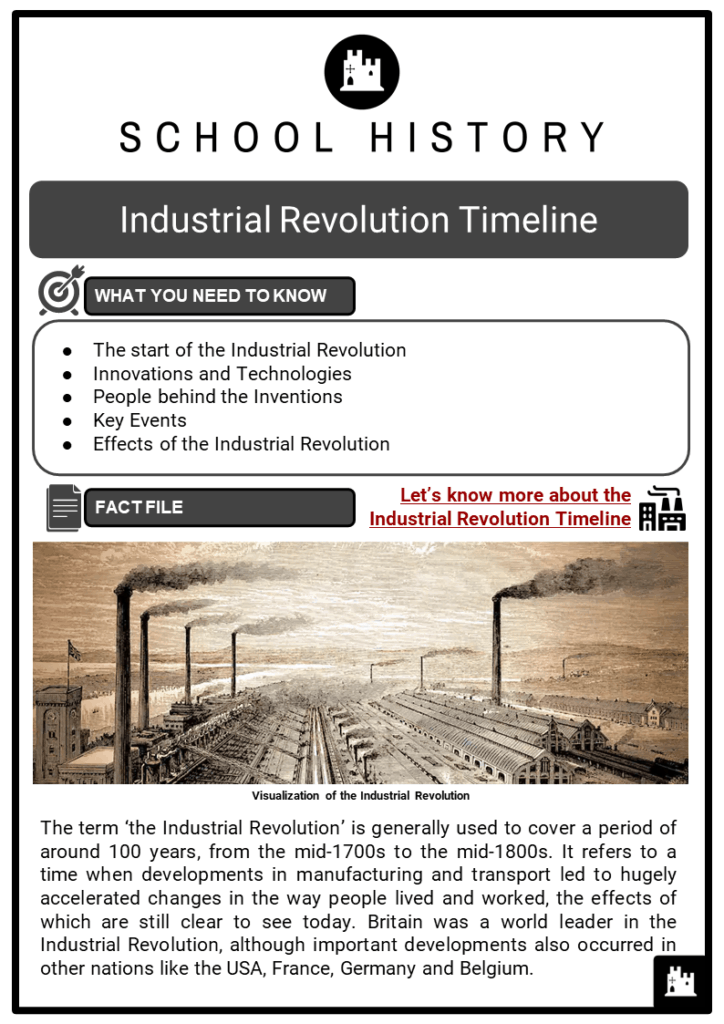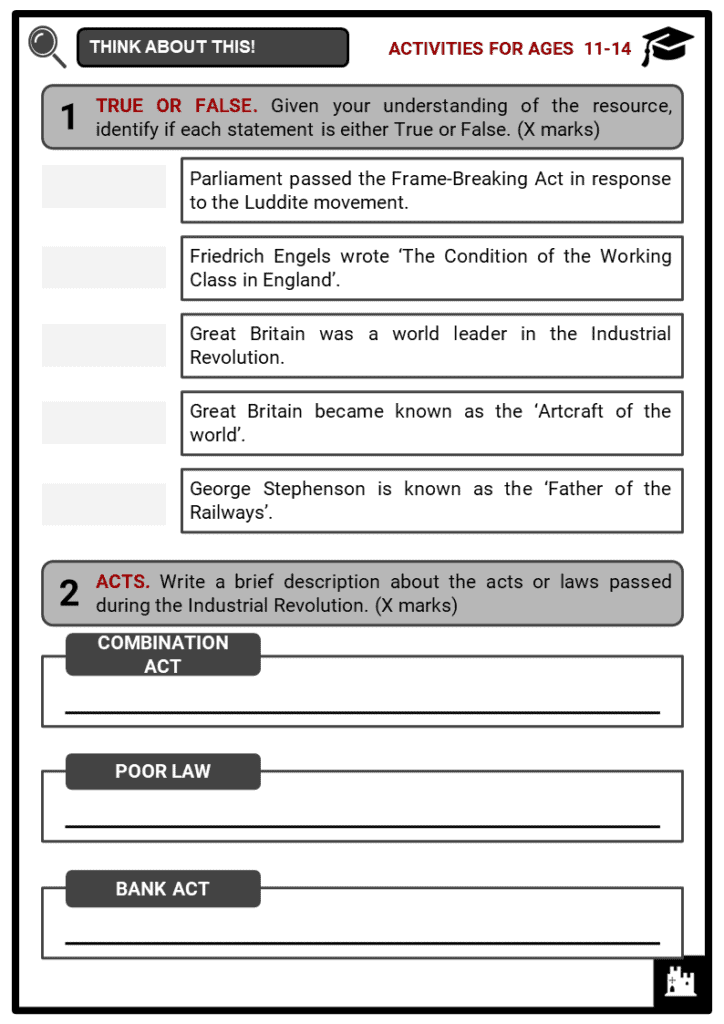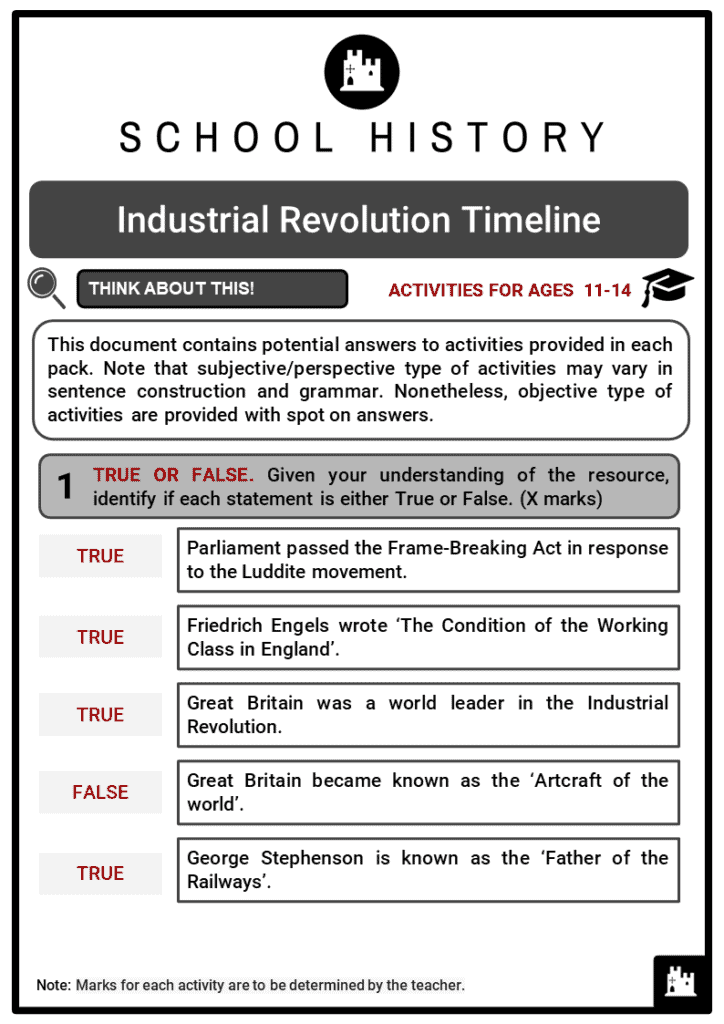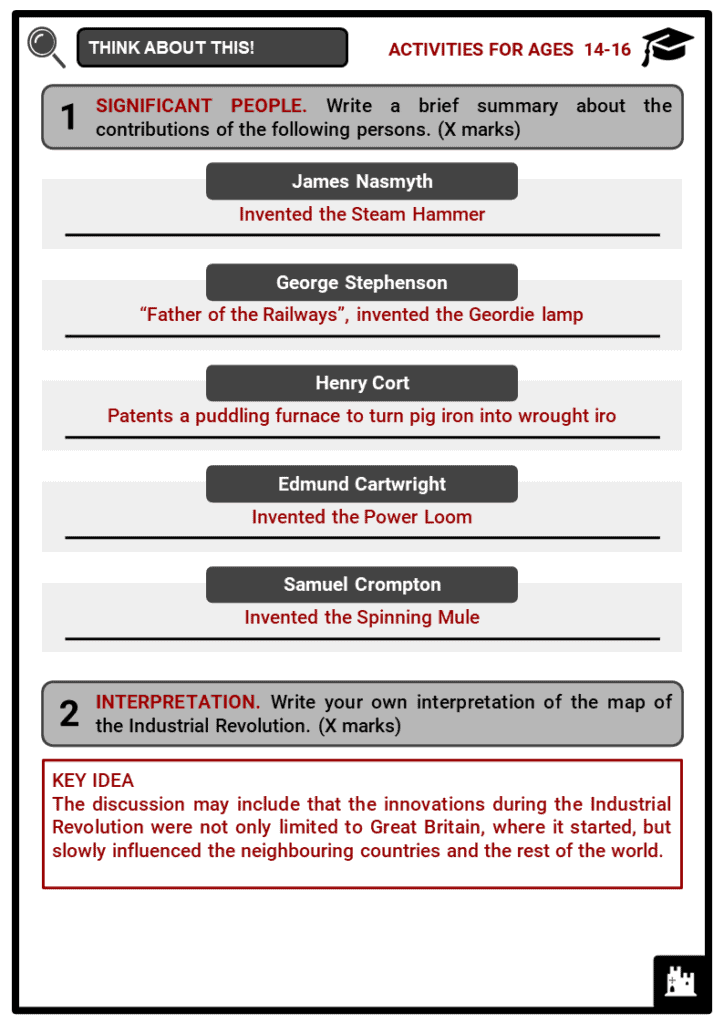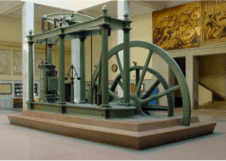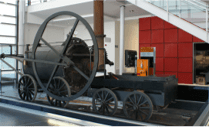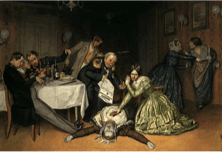Download Industrial Revolution Timeline Worksheets
Do you want to save dozens of hours in time? Get your evenings and weekends back? Be able to teach Industrial Revolution Timelineto your students?
Our worksheet bundle includes a fact file and printable worksheets and student activities. Perfect for both the classroom and homeschooling!
Table of Contents
Add a header to begin generating the table of contents
Summary
- The start of the Industrial Revolution
- Innovations and Technologies
- People behind the Inventions
- Key Events
- Effects of the Industrial Revolution
Key Facts And Information
Let’s know more about the Industrial Revolution Timeline
- The term ‘the Industrial Revolution’ is generally used to cover a period of around 100 years, from the mid-1700s to the mid-1800s. It refers to a time when developments in manufacturing and transport led to hugely accelerated changes in the way people lived and worked, the effects of which are still clear to see today. Britain was a world leader in the Industrial Revolution, although important developments also occurred in other nations like the USA, France, Germany and Belgium.
- There were many key inventions during the Industrial Revolution, with engineers and businessmen using the ideas of those who had gone before them to build their own new developments and make great leaps forward in technology.
- Some historians refer to a proto-Industrial Revolution taking place in the decades preceding, with innovations like Abraham Darby’s discovery of a method of smelting iron using coal instead of charcoal in 1709, or Thomas Newcomen’s invention of a steam-powered engine in 1712.
- Some even cite the founding of the East India Company in 1600 as a catalyst for Britain bringing a high level of organisation to its trade relationships and productivity.
- At a time when Britain and other nations were frequently involved in war overseas, many industrial developments stemmed from a desire for better manufacturing of armaments, before also being used for other applications.
- Conversely, Britain itself was experiencing a period of relative peace within its borders, a state of affairs which allowed business and industry to flourish while armed uprisings and wars hindered the efforts of other countries.
- Early innovations paved the way for change, which grew increasingly rapid as the years went by. Industry in Britain in the 18th century was on a small scale, with people making things largely by hand and often within their own home.
- Following the Industrial Revolution, the majority of British people lived in cities.
- Production was increasingly mechanised and on a large scale, meaning that goods could be produced in a quantity and efficiency that made them widely available.
- By the time of the Great Exhibition of 1851, it could be said that the consumer age had truly dawned.
- 1761
- The first canal of the Industrial Revolution period opens: the Bridgewater Canal linking the coal mines of Worsley to Manchester.
- The canal network develops rapidly as a means of improving transport links so the products of industry can reach the market more quickly.
- 1764
- James Hargreaves invents the spinning jenny, a device which enables textile workers to make yarn from raw cotton more quickly, marking the beginnings of the revolution in cloth manufacture.
- 1765
- James Watt discovers a way to make the earlier Newcomen steam engine run more efficiently.
- He is granted a patent for this invention.
- The steam engine becomes one of the key drivers of the Industrial Revolution, changing transport and manufacturing forever.
- 1769
- Richard Arkwright patents a water frame, a machine which can produce stronger thread than the spinning jenny as it is powered by water. It also requires virtually no skill to operate, making it the basis of the modern factory system.
- 1776
- Adam Smith publishes his hugely influential work “The Wealth of Nations”, an examination of economics divided into topics like labour, stocks and national budgets.
- 1779
- Samuel Crompton invents the spinning mule – a device that combines the processes of spinning and weaving in one machine.
- Crompton’s mule is used widely throughout the textile industry for more than a century, although he cannot afford to patent his idea and so receives no royalties.
- 1784 - 1785
- Henry Cort patents a puddling furnace to turn pig iron into wrought iron, which is far more useful in making machinery, weapons and other goods.
- Edmund Cartwright patents a wool-combing machine, another important contributor to the automation of the textile industry.
- 1799
- Parliament passes the Combination Act, forbidding workers from forming unions. The government recognises that the new working conditions might cause workers to band together and go on strike, potentially hampering productivity.
- 1801
- Having invented a way of harnessing high-pressure steam to drive an engine, mining engineer Richard Trevithick drives his road locomotive “Puffing Devil” through Camborne, Cornwall.
- 1803
- The technological advances in the cotton manufacturing industry lead to it overtaking wool as Britain’s largest export.
- 1804
- Richard Trevithick’s Pen-y-Darren steam locomotive pulls ten tons of iron and 70 men nearly ten miles along a tramway from Merthyr Tydfil, Wales. This is the first steam-hauled railway journey on a track.
- 1805
- The Grand Junction Canal is completed, improving the journey by water from the Midlands to London.
- 1809
- After the first steamships have navigated rivers, the first to take an ocean voyage is the Phoenix, travelling between New York and Philadelphia, USA. By the end of the 19th century the steam revolution has made ocean voyages many times faster and cheaper.
- 1811
- The first large-scale Luddite riot takes place in Nottingham. Over the next few years, the Luddites damage factory machinery to protest against working conditions and the increasing redundancy of traditional crafts like weaving. The army is brought in to contain the uprising.
- 1812
- Parliament passes the Frame-Breaking Act in response to the Luddite movement, making destruction of machinery, or even entering a building with the intention to do this, punishable by death.
- 1815
- Sir Humphrey Davy invents a safety lamp for miners, enabling them to have underground light while reducing the risk of explosions.
- At almost exactly the same time, engineer George Stephenson also invents a lamp for miners known as the Geordie lamp.
- Both lamps also indicate the presence of dangerous gases, a significant risk when tunnelling underground.
- 1816 - 1824
- Stephenson registers a patent for various developments of steam locomotive technology in 1816, including overlapping railway track pieces. His contribution to the industry earns him the nickname ‘Father of the Railways’.
- In 1824, the Combination Act, forbidding workers to use collective bargaining, is repealed, leading to a spate of strikes as people utilise the right to withdraw their labour to try and improve their working conditions.
- 1825
- The first steam-powered passenger railway opens between Stockton and Darlington in the north-east of England, using Locomotion No. 1, although its primary purpose is transporting coal from mines to port. George Stephenson is the lead engineer.
- 1830
- Stephenson and his son Robert create the first public intercity railway line in the world, linking Manchester and Liverpool.
- Despite an opening day tragedy when the MP for Liverpool is killed by the Rocket locomotive, the line is very successful, as it gives easy access to the port of Liverpool from the inland Lancashire manufacturing towns.
- 1833-1834
- The Factory Act bans children under nine from working in the textile industry.
- Those aged between nine and 13 cannot work longer than nine hours a day, and 13 to 18-year-olds not longer than 12 hours. No children are allowed to work night shifts.
- In 1834, the Poor Law is passed to reform the poverty relief system. Workhouses are built that are intended to be so bad that only the desperate will seek help in them, saving the state money.
- 1839
- Scotsman James Nasmyth invents the steam hammer at the same time as Frenchman François Bourdon. The hammer is used in large-scale metalworking for pile-driving, forging and riveting.
- 1842
- After a royal commission publicises the conditions of mineworkers following a disaster in a Yorkshire pit in 1838, the Mines and Collieries Act bans children under 10 and females from working underground.
- 1844
- Friedrich Engels writes ‘The Condition of the Working Class in England’ after observing the labouring poor in the cities of Manchester and Salford.
- Overcrowded industrial cities are hotbeds of disease and unrest, but also crucibles of movements for societal change. In the same year, the Bank Act standardises and restricts the production of banknotes.
- 1847
- The working hours of women and children in textile factories are limited to 10 per day, despite opposition from many mill owners who fear that their profits will be affected by limits on labour.
- 1848
- A two-year cholera epidemic begins in Britain. Although it is not known at the time, the disease comes from contaminated water, which in overcrowded cities can be collected from the same pump by many people in a short time, speeding up the spread of the infection.
-
- Prince Albert organises the Great Exhibition in Hyde Park, celebrating achievements in industry and design from around the world, with the intention of showcasing Britain’s leadership in the fields. The Prince is famous for his enthusiasm for new technologies.
- Over the course of around one hundred years, the lives of people in Britain and other countries were transformed by the changes brought about by the Industrial Revolution. Britain transformed from a largely rural economy to an industrial powerhouse, manufacturing and trading goods around the world.
- The concept of the large factory appeared, with these buildings coming to dominate the skyline of the towns and cities at the heart of the Industrial Revolution.
- Clustered around the factory buildings were countless small dwellings, built to house the many workers who were needed to keep the factories running.
- Overcrowding was evident in these places, and disease spread rapidly.
- People worked at hard, monotonous jobs for many hours a day, with little time off, and little protection from unjust working conditions imposed by factory owners and overseers.
- Successive governments struggled to keep up with the pace of change, as new legislation had to be drawn up to deal with and regulate working conditions
- However, as the Industrial Revolution reached its height in the early 19th century, campaigners were already trying to improve the situation of the working poor and get workers’ rights enshrined in law.
- The transport revolution began to open up more opportunities for visiting areas outside of people’s immediate locations for working and living.
Seaside resorts flourished as the railways linked them to major cities. - Transport was a key factor in the growth of industry.
- The railways, and before them the canals, enabled goods to be taken quickly and cheaply to ports, where they could be loaded onto steamships and transported across the globe. The transport network was a growth industry in itself, requiring the manufacture of tracks, locomotives and ships in factories or shipyards, and all the human labour and sourcing of raw material that went along with that.
- Another key factor was the banking system, which had been stabilised and now allowed people to raise capital – much needed if investing in a new business venture – using credit or mortgages.
- For thousands of years, the majority of human lives had been ruled by the seasons, by the needs of agriculture and livestock, but the Industrial Revolution broke this cycle irreparably.
- For many people, it was the clock, not the sun, that now governed their days. There were more opportunities open to them, more goods to buy and money to buy it with, but there were also more dangers and hardships
- By 1850, more than half of Britain’s citizens lived in urban areas; the country owned half the world’s railway track and half its oceangoing ships. Its leading role in industrial innovation and global trading network led Britain to become known as the ‘workshop of the world’.
Image sources:

